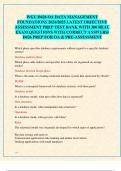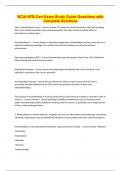WGU D426 OA DATA MANAGEMENT
FOUNDATIONS 2024/2025 LATEST OBJECTIVE
ASSESSMENT PREP TEST BANK WITH 300 REAL
EXAM QUESTIONS WITH CORRECT ANSWERS/
D426 PREP FOR OA & PRE-ASSESSMENT
Which phase specifies database requirements without regard to a specific database
system?
Database analysis phase
Which phase adds indexes and specifies how tables are organized on storage
media?
Database physical design phase
What is the name of a leading relational database system that sponsored by Oracle?
MySQL
What is a conceptual framework for database systems, with three parts?
Database model
In a database model, what prescribes how data is organized?
Data structures
In a database mode, what manipulates data structures?
Operations
In a database mode, what governs valid data?
Rules
The relational model was originally developed for which types of applications?
Big data storage and analysis
Transactional applications like banking and airline reservations
Desktop applications with small databases
pg. 1
,Transactional applications like banking and airline reservations
What was the initial impediment to commercial adoption of relational databases in
the early 1980s?
Reliability
Processing speed
Cost
Processing speed
Which terms are commonly used in database processing?
Tuple, relation, attribute
Row, table, column
Record, file, field
Row, table, column
In the relational data structure, which components are named?
Data type, row, table
Data type, table
Data type, table, column
Data type, table, column
Name three relational operations.
Select, project, and union
Square root, exponent, and logarithm
Integrate and differentiate
Select, project, and union
An SQL statement can implement only one relational operation.
True - Most SQL queries cannot implement several operations
False - Most SQL queries implement several operations
False - Most SQL queries implement several operations
pg. 2
,What are the 3 Relational rules?
Square root, exponent, and logarithm
Integrate and differentiate
Unique primary key, Unique column names, No duplicate rows
Unique primary key, Unique column names, No duplicate rows
Delete cascade is an example of a relational rule.
True - is an example of a relational rule.
False - Delete cascade is a business rule, not a relational rule.
False - Delete cascade is a business rule, not a relational rule.
The relationship (within the relation) that describes how the value of one attribute
may be used to find the value of another attribute.
Functional Dependency
3 multiple choice options
An attribute that can be used to find the value of another attribute in the relation.
Determinant
3 multiple choice options
Value can be used to find the value of every other non-key attribute in the table.
Unique and minimal.
Candidate Key
3 multiple choice options
Define & manage database structures
DDL
2 multiple choice options
Adding, deleting, and modifying data - Manipulates data stored in a database.
DML
2 multiple choice options
Used to create user accounts, manage permissions and access.
DCL
pg. 3
, 2 multiple choice options
Includes CREATE, DROP, ALTER, TRUNCATE, RENAME
DDL
2 multiple choice options
A view created and stored on the database. Underlying data is changed and also
updated in this view. Uses memory space.
Materialized View
2 multiple choice options
Not stored in memory. Only computed when used or accessed.
Virtual View
2 multiple choice options
The data about the data. Describes elements such as columns, names, and data
type.
Metadata
3 multiple choice options
Ordered collection of elements in parentheses.
Tuple
3 multiple choice options
% of table rows selected by a query
Hit Ration
3 multiple choice options
Reads blocks directly, without accessing an index.
Table Scan
3 multiple choice options
Reads index blocks sequentially in order to locate the needed table blocks.
Index Scan
pg. 4





